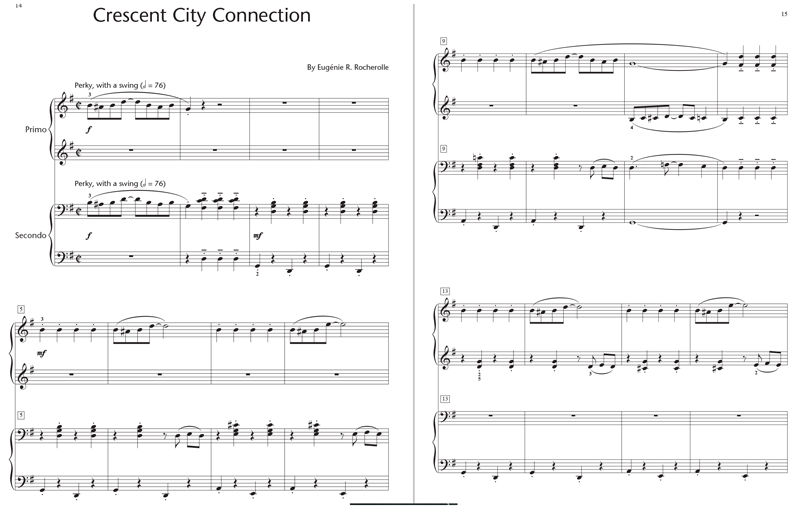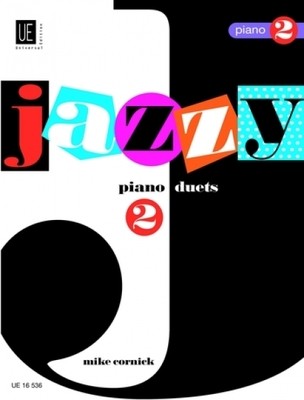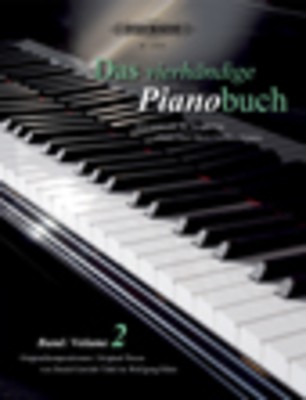The benefits of duet and ensemble playing are well-known, with the potential to help develop better listening, rhythmic, and general musicianship skills. Recently, I wanted to explore outside the ‘standard’ published collections. You know the ones: typically published/compiled about 40 or more years ago, filled with classical warhorses of the duet repertoire. Many of these volumes are much loved, but in more recent times, there have been numerous volumes of duet and ensemble repertoire that offer new options to explore – both classical and popular-inspired. It’s always a challenge to evaluate duets and trios properly without the help of colleagues, so with a few close friends and some of my advanced students, I recently read through cover-to-cover about 30 volumes of duets and trios. We also laughed ourselves silly and had a great deal of fun! (Thanks to Bettina, Oscar, Mark, Jenni, Stephen and my students!) Here are some of the best volumes we found recently:
Manfred Schmitz’s Mini Tango (Volume 2, published by Deutscher Verlag für Musik, DV32150) contains 18 trios for six hands at the one piano. An absolutely fantastic volume, starting with the equivalent of AMEB Prelim-Grade 1 at the beginning, proceeding through to about a Grade 5 standard. The earliest pieces are just a few lines long, with clear patterns in the writing, sensible hand positions, with interest in every part. The latter pieces would be ideal performance showcases. Most pieces have parts that are essentially matched in difficulty, or within one grade of each other, meaning that three students could perform the pieces together. The music is often highly spirited with clear, immediate characters and interesting rhythms, as you might expect with tango-inspired pieces! The volume itself is beautifully laid out with fold out pages. One of my favourites in the volume was no.9 – translated as “Lonely Dancing Girl”, at about Grade 2/3 level. A fantastic discovery into the world of piano trios and a complete hit with the students. Had I mentioned I absolutely loved this book?!
More Hands, One piano, assembled by Peter Przystaniak (published by Edition Peters, Nr. 11106) is a terrific collection of originals by Peter Przystaniak and his arrangements of various songs and folk tunes, for six and eight hands. It caters to younger learners beautifully, with the hardest pieces around a Grade 2 level technically, with most of the book capable of being played by Preliminary levels upwards. Hand positions are very well thought out and comfortable – mostly spanning 5-finger positions over 5 notes (or very occasionally 6 notes) for each player. It may find use in group instruction classes as well as private teachers wanting to explore ensemble playing with their students. Some of the traditional pieces arranged include Brahms’ Lullaby, Old MacDonald, Greensleeves and Swanee River. Przystaniak’s originals are the highlight of the volume for me, with Jungle Boogie and Tango di Mango holding lots of appeal. Comes with a CD for practicing with other parts.
“The sound world and energy of these pieces have made for plenty of enthusiastic and spirited performances by young players”
I’ve been a fan of Sonny Chua’s piano works for children for some time, and was thrilled to find his 2009 volume Many Hands, One Piano. This volume contains a combination of duets, trios and sextets that have been very popular in my studio for the past five years. The “Day in the Life of a T-Rex” duets are my personal picks of the volume, particularly the “T-Rex Awake” (easily managed by Grade 1/2 players) and “T-Rex Hungry” (Grade 2/3) movements. With descriptive markings like “feverishly”, “snappingly” and “cantankerously”, the sound world and energy of these pieces have made for plenty of enthusiastic and spirited performances by young players. There are other appealing works based on “Three Blind Mice”, and Gershwin’s “I’ve Got Rhythm” gets the Chua cheeky treatment with a piece for six hands called “We’ve Got Rhythm”.
[accordion]
[item title=”Sample Page”] [/item]
[/item]
[/accordion]
Double Agent! Piano Duets, arranged by Jeremy Siskind (published by Hal Leonard, ISBN 978-1-4803-5280-3) features eight works along the “Secret Agent” theme – including favourites like Get Smart, Inspector Gadget, James Bond, Mission Impossible and Pink Panther. The volume is catered to the intermediate level pianist, with creative, interesting arrangements that sound like authentic jazz, with great harmonies and rhythmic interest. Ranging from about Grade 2/3 (Get Smart) to Grade 5 (Mission Impossible), I think the highlight of this volume is the James Bond arrangements (Grade 4/5). When the piece bursts into the ‘swing’ section mid-way, what an unbeatable moment! Given the jazz nature of the volume, there are a few moments with rhythmical challenges, but the artistic and learning rewards are well worth the effort as the results are ear/attention-grabbing. A new favourite with my students.
[accordion]
[item title=”Sample Page”] [/item]
[/item]
[/accordion]
Mike Cornick’s Easy Jazzy Duets Piano (UE16577) and Jazzy Duets Piano 2 (UE 16536) are both excellent volumes published by Universal Edition. Easy Jazzy Duets Piano have secondo parts at a slightly more advanced level than the primo parts, but all items and parts in this book are within the Grade 3 to 5 level. The Jazzy Duets Piano 2 volume mostly has both primo and second parts at the same level of difficulty, with the pieces ranging from Grade 4 to 6. Wonderful, interesting harmonies, and the quality of the music – extremely well-written – immediately comes through.
20th Century Classics – Volume One (published by Boosey and Hawkes, ISMN M-060-08478-2) feature ten orchestral landmarks of the 20th Century, arranged well by Roger Brison for piano duet. So much of the orchestral repertoire exists in arrangements for piano duet (or two pianos) and this is a fantastic way to get students to know this rich repertoire. This collection highlights works by Bernstein (‘America’ from West Side Story), Britten’s Young Person’s Guide to the Orchestra, Aaron Copland’s Fanfare for the Common Man, and movements from Prokofiev’s Classical Symphony and Romeo and Juliet, amongst others. The arrangement of the Rachmaninoff’s Piano Concerto No.2 is hit with younger and older players alike. Most of the parts would be playable by approximately Grade 4 level students, however there some trickier moments. I tend to use this volume with my more advanced students, for quicker study ensemble study pieces and sight reading in the lesson. The pieces are mostly just a page or two in length. Also a great starting point to introduce concepts of orchestral colour into one’s playing.
Christopher Norton’s multiple duet volumes in the Microjazz series are well-known, and well suited to younger players (from early levels through to about Grade 3-4 at most challenging.) His separate volume of Latin Duets (published by Boosey and Hawkes, Nr.9777) start at about the Grade 4 level, moving through to about an advanced Grade 6. My students have particularly enjoyed the first piece in the Latin collection, “Mambo”, where the parts are very well matched and alternate features. There is also the Rock Duets volume which is highly recommended.
[accordion]
[item title=”Sample Page”] [/item]
[/item]
[/accordion]
The Hal Leonard Piano Recital Showcase series contains some terrific, clearly graded volumes of solo repertoire, and a welcome addition to this series is the duet volume entitled Duet Favourites (ISBN 978-1-4584-2243-9). It features four of Hal Leonard’s composers, including Eugénie Rocherolle, Phillip Keveren, Wendy Stevens and Sondra Clark, with duets of an intermediate level, all of a more substantial feature length. The volume could be technically managed by pianists around a Grade 4 level, though some parts are slightly easier at about a Grade 3 level. Rocherolle’s “Crescent City Connection” is a favourite, but the entire volume is notable for its variety of styles and pianistic, idiomatic writing.
[accordion]
[item title=”Sample Page”] [/item]
[/item]
[/accordion]
Das vierhändige Pianobuch [The Four-Hand Piano Book] (Volume 2, published by Edition Peters) is an intriguing collection of relatively unusual or unknown originals, by composers well-known (Dvořák, Satie, Mozart, Kuhlau, Grieg, etc) and new compositions/commissions by modern-day composers. The collection’s subtitle is Piano Duet Music for Discoverers, which well affirms the general feeling of the volume. Piece choices are out of the ordinary, with even the works of the traditional composers from lesser-known opuses. There are 17th-century pieces alongside new, quasi-improvised works with contemporary notation. There are no standard “warhorses” included; after all, there are numerous published volumes that already cater to that well. The parts are very well matched, and the selection of works appeals strongly to one’s creativity and curiosity. The volume has more of a classical contemporary feel, as opposed to the more common jazz-inspired volumes, which makes it a very useful resource. I’m looking forward to seeing Volume 1 of this series, which classifies itself as for easy-intermediate levels. This volume is certainly at the intermediate level, Grade 4 and upwards, and well worth exploring.
[infobox maintitle=”You may also be interested in” subtitle=”The Busy Teachers’ Guide To Repertoire: Solo Collections” bg=”red” color=”black” opacity=”off” space=”30″ link=”http://thepianoteacher.com.au/articles/the-busy-teachers-guide-to-repertoire-solo-collections/”]










